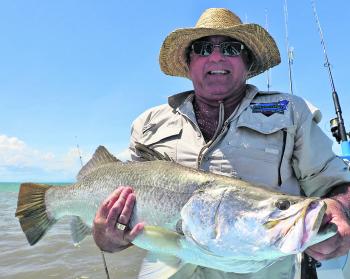February was a certainly the hottest month I have ever spent on the water. Some days I just couldn’t wait to get of the water, and that’s unusual for me.
I don’t normally burn because I have spent so much of my life in the sun, but the past month has made me feel like a prune in a furnace. No thunder storms and very little rain has made it more oppressing, especially when you see the southern states getting smashed by rain and storms.
Fishing has been quiet in the shallows, which has not been good news for the lure casters, thanks to the extreme heat in the water. I have seen it as high as 34°C in deeper waters and it would be even more in the shallow water. Last time I saw these conditions were back in the mid ‘90s when we went through the last period of super hot years.
My only suggestion to lure casters would be to stick to the larger tides and cloudy days, as this will be your best opportunity to get fish coming in shallow again. The larger tides move the water around more, bringing some of the cooler water to the shallows.
I have had a pretty good start to the barra season, but I’m doing most of my fishing in 9-10m of water. Clients have been enjoying some great barra captures with a lot of fish in the 90cm bracket.
Reef reports have been fairly average, mainly due to those stubborn hot northerlies. The best results have come from anglers fishing very wide and very deep during the night hours. One crew managed to run into a few giant reef mangrove jacks with one nudging the 12kg, mark but I couldn’t get hold of any pictures. Reef fishing will still continue to fish best at night while we have this hot weather upon us.
I also heard of some good captures of big golden snapper (fingermark) as well as the odd black jew coming from the Cape Sandwich area, which has been proven a great spot over the years. Live squid and herring are the number one baits for these species and you can also catch some big oceanic grunter amongst them too at this time of year.
These are all fine eating species, but always remember to take only what you need, as barotrauma will kill most fish in the deeper headland waters, so there’s not much point catching and releasing after you have reached your bag limit.
During March, I would expect to see much of the same, but it will depend on whether or not we see any monsoonal activity. We’re leaning towards another dry depressing season, but who knows what might be around the corner. If we do get some floodwaters, then some of our inshore fishing will go quiet momentarily, and if this occurs I would recommend getting out around the islands and targeting a few queenfish, GT and northern bluefin tuna as well as the golden snapper down on the bottom.
For those who like a bit of marlin fishing, it’s that time of year we get a few mid sized fish around the 50-150kg size coming in to feed on the small northern blue schools, which is a whole lot of fun when it works. Trolling some bridle rigged live tuna and some bigger skip baits is the go for best results. The tuna schools are usually found on the outskirts of the islands on the inner shipping lane.
If you are interested in our online courses or charters head over to www.ryanmoodyfishing.com. We hope to have our new site up and running during March, but will let you all know in next month’s column.
• If you would like to book a charter or join our fishing community for some great fishing competitions etc, head on over to www.ryanmoodyfishing.com. And you could also win a free charter drawn twice a year.
Reads: 1243
There’s been lots of barra in the 90cm range for clients so far.

The author with a nice thready from early February.




